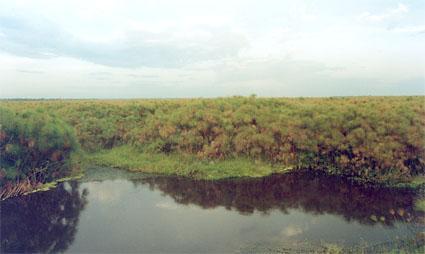Lake Nakuwa Wetland System
Lake Nakuwa Wetland System
- País:
- Uganda
- Número del sitio:
- 1635
- Superficie:
- 91,150.0 ha
- Fecha de designación:
- 15-09-2006
- Coordenadas:
- 01°15'N 33°31'E
Carousel
CarouselLos materiales presentados en este sitio web, particularmente los mapas y la información territorial, se proporcionan tal cual y según están disponibles a partir de los datos de los que se dispone y no implican la expresión de opinión alguna por parte de la Secretaría de la Convención de Ramsar respecto de la condición jurídica de ningún país, territorio, ciudad o zona, ni de sus autoridades, ni respecto de la delimitación de sus límites o fronteras.
Lake Nakuwa Wetland System. 15/09/06; Kamuli, Pallisa, Soroti; 91,150 ha; 01°15'N 033°31'E. Important Bird Area. A permanent wetland associated with a number of satellite lakes and a swamp system dominated by dense papyrus, broken in parts by pools of water-forming sudds (clumps of floating papyrus). In addition to supporting the Sitatunga and the Nile Crocodile, the system and its satellite lakes contain the most diverse cichlid species assemblage and are a haven for a number of non-cichlid species no longer found in the large lakes of Kyoga and Victoria. The system provides refuge to fish taxa that have been reported extinct in the main lakes, thanks to the protection accorded by the aquatic vegetation around the lakes, which prevented the Nile perch from spreading there. The wetland also plays an important role in flood prevention, water purification and groundwater recharge. It is probably one of the remaining pristine wetland areas in Uganda due to its remoteness and sparse population in the immediate catchment, and it offers employment to a number of fishermen. The papyrus is used for making mats, thatching, and crafts. The potential threats to fish species diversity include human exploitation, collection of ornamental fish for export, degradation of the fish habitat, spread of the Nile Perch, and water hyacinth. Papyrus over-harvesting and land reclamation for agriculture also constitute a threat. Ramsar site no. 1635. Most recent RIS information: 2006.
Región administrativa:
Kamuli, Pallisa, Soroti districts
Fecha de última publicación:
15-09-2006
Ficha Informativa de los Humedales de Ramsar (FIR)
- UG1635RIS.pdf
- UG1635map.pdf
Mapa del sitio
Informes y documentos adicionales
Taxonomic lists of plant and animal species occurring in the site
